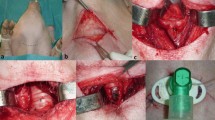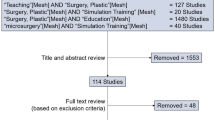Abstract
Purpose
To assess and compare the feasibility of using ovine and porcine models as surgical simulation training tools for otolaryngology trainees performing parotid surgery and facial nerve dissection.
Methods
Trainees performed parotid surgery (total parotidectomy, retrograde facial nerve dissection and facial nerve grafting) on an ovine and porcine model. Participants completed a 22-item, five-point Likert scale questionnaire on each model, assessing three validation domains; face validity (FV), global content validity (GCV) and task-specific content validity (TSCV). Data were prospectively collected and analysed using descriptive and non-parametric statistics.
Results
Twelve trainees completed two consecutive parotidectomies and facial nerve dissections on an ovine and porcine model. Twenty-four dissections were completed. Validation questionnaires were completed for each model by all trainees. The ovine model achieved median validation threshold scores (≥ 4/5) for all aspects of FV, GCV and TSCV. The porcine model did not achieve validation threshold scores for any aspect of the validation questionnaire. Comparison of the ovine and porcine model demonstrated that the ovine model was statistically superior to the porcine model across most validation criteria excluding realistic appearance of skin, identification and ligation of the trans-oral parotid duct and facial nerve grafting.
Conclusion
Adequate experience with facial nerve dissection during parotid surgery is vital to ensuring good outcomes and avoiding complications. This study is the first to compare validity of two animal models for simulation training in parotid surgery and facial nerve dissection. We have validated the ovine model as a useful tool for simulation training and advocate its incorporation into otolaryngology training programmes.





Similar content being viewed by others
Reference
Wiet GJ, Stredney D, Wan D (2011) Training and simulation in otolaryngology. Otolaryngol Clin N Am. 44(6):1333–1350
Malekzadeh S, Malloy KM, Chu EE, Tompkins J, Battista A, Deutsch ES (2011) ORL emergencies boot camp: using simulation to onboard residents. Laryngoscope. 121(10):2114–2121. https://doi.org/10.1002/lary.22146
Sturm LP, Windsor JA, Cosman PH, Cregan P, Hewett PJ, Maddern GJ (2008) A systematic review of skills transfer after surgical simulation training. Ann Surg. 248(2):166–179
Kurashima Y, Hirano S (2017) Systematic review of the implementation of simulation training in surgical residency curriculum. Surg Today. 47(7):777–782
Zigmont JJ, Kappus LJ, Sudikoff SN (2011) Theoretical foundations of learning through simulation. Semin Perinatol. 35(2):47–51
Papadogeorgakis N (2011) Partial superficial parotidectomy as the method of choice for treating pleomorphic adenomas of the parotid gland. Br J Oral Maxillofac Surg. 49(6):447–450
Wong WK, Shetty S (2018) The extent of surgery for benign parotid pathology and its influence on complications: a prospective cohort analysis. Am J Otolaryngol. 39(2):162–166
Milner TD, Okhovat S, Clement WA, Wynne DM, Kunanandam T (2019) A systematic review of simulated laryngotracheal reconstruction animal models. Laryngoscope. 129(1):235–243
Ianacone DC, Gnadt BJ, Isaacson G (2016) Ex vivo ovine model for head and neck surgical simulation. Am J Otolaryngol. 37(3):272–278
Okhovat S, Milner TD, Clement WA, Wynne DM, Kunanandam T (2020) Validation of animal models for simulation training in pediatric laryngotracheal reconstruction. Ann Otol Rhinol Laryngol 129(1):46–54
Levine SM, Esrig RP (2000) The facial nerve in animals. In: May M, Schaitkin BM (eds) The facial nerve, 2nd edn. Georg Thieme Verlag, New York, pp 107–112
Niimi Y, Matsumine H, Fukuda S, Salsbury JR, Niimi Y, Herndon DN et al (2019) Surgical anatomy of ovine facial and hypoglossal nerves for facial nerve reconstruction and regeneration research: an experimental study in sheep. Microsurgery. https://doi.org/10.1002/micr.30405
Sasaki R, Watanabe Y, Yamato M, Aoki S, Okano T, Ando T (2010) Surgical anatomy of the swine face. Lab Anim. 44(4):359–363
Deutsch ES, Wiet GJ, Seidman M, Hussey HM, Malekzadeh S, Fried MP (2015) Simulation activity in otolaryngology residencies. Otolaryngol Neck Surg. 153(2):193–201. https://doi.org/10.1177/0194599815584598
Musbahi O, Aydin A, Al Omran Y, Skilbeck CJ, Ahmed K (2017) Current status of simulation in otolaryngology: a systematic review. J Surg Educ. 74(2):203–215
Sturm L et al (2007) Surgical simulation for training: skills transfer to the operating room. ASERNIP-S Report No. 61. Adelaide, South Australia: ASERNIP-S
Netto FACS, Zacharias P, Cipriani RFF, Constantino MDM, Cardoso M, Pereira RA (2015) A porcine model for teaching surgical cricothyridootomy. Rev Col Bras Cir. 42(3):193–196
Soliman AMS, Ianacone DC, Isaacson GC (2018) Ex vivo ovine model for teaching open laryngotracheal surgery. World J Otorhinolaryngol Head Neck Surg. 4(2):140–144
Chark D, Oliaei S, Manuel C, Wong BJ (2011) Porcine cartilage model for simulation of nasal tip aesthetics and mechanics. Aesthet Surg J. 31(5):501–505
de Garcia LB, de Andrade JSC, Testa JRG (2014) Anatomical study of the pigs temporal bone by microdissection. Acta Cir Bras 29(suppl 3):77–80
Gocer C, Eryilmaz A, Genc U, Dagli M, Karabulut H, Iriz A (2007) An alternative model for stapedectomy training in residency program: sheep cadaver ear. Eur Arch Oto-Rhino-Laryngol. 264(12):1409–1412
Seibel VAA, Lavinsky L, De Oliveira JAP (2006) Morphometric study of the external and middle ear anatomy in sheep: a possible model for ear experiments. Clin Anat. 19(6):503–509
Acknowledgements
The authors would like to thank Dr Hannah Phylip for providing anatomical diagrams for the paper.
Funding
Departmental Research Grant.
Author information
Authors and Affiliations
Contributions
All authors contributed to the study creation, with the following contributions listed: Conceptualisation: TDM, SO. Design: TDM, SO. Delivery of study: TDM, SO, Clement, Kunanandam. Analysis: TDM, SO, MM, Clement, Kunanandam. Manuscript preparation: TDM, SO, MM. Reviewing and editing: Clement, Kunanandam. Funding acquisition: Kunanandam.
Corresponding author
Ethics declarations
Conflict of interest
The authors declare that they have no competing interests.
Human and animal participants
All the animal models were obtained from a licensed medical meat supplier compliant with all UK and EU regulations. The use of each model was performed within the criteria of STROBE guidelines and Animal Research: reporting In Vivo Experiments guidelines.
Ethical approval
Departmental approval was granted for use of animal tissue. No animal was specifically slaughtered for the purpose of this study.
Informed consent
Not applicable.
Additional information
Publisher's Note
Springer Nature remains neutral with regard to jurisdictional claims in published maps and institutional affiliations.
Rights and permissions
About this article
Cite this article
Milner, T.D., Okhovat, S., McGuigan, M. et al. Feasibility of ovine and porcine models for simulation training in parotid surgery and facial nerve dissection. Eur Arch Otorhinolaryngol 277, 1167–1175 (2020). https://doi.org/10.1007/s00405-020-05782-6
Received:
Accepted:
Published:
Issue Date:
DOI: https://doi.org/10.1007/s00405-020-05782-6




